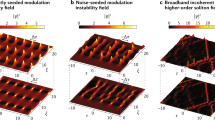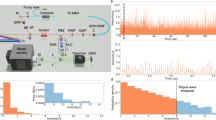Abstract
Recent observations show that the probability of encountering an extremely large rogue wave in the open ocean is much larger than expected from ordinary wave-amplitude statistics1,2,3. Although considerable effort has been directed towards understanding the physics behind these mysterious and potentially destructive events, the complete picture remains uncertain. Furthermore, rogue waves have not yet been observed in other physical systems. Here, we introduce the concept of optical rogue waves, a counterpart of the infamous rare water waves. Using a new real-time detection technique, we study a system that exposes extremely steep, large waves as rare outcomes from an almost identically prepared initial population of waves. Specifically, we report the observation of rogue waves in an optical system, based on a microstructured optical fibre, near the threshold of soliton-fission supercontinuum generation4,5—a noise-sensitive5,6,7 nonlinear process in which extremely broadband radiation is generated from a narrowband input8. We model the generation of these rogue waves using the generalized nonlinear Schrödinger equation9 and demonstrate that they arise infrequently from initially smooth pulses owing to power transfer seeded by a small noise perturbation.
This is a preview of subscription content, access via your institution
Access options
Subscribe to this journal
Receive 51 print issues and online access
$199.00 per year
only $3.90 per issue
Buy this article
- Purchase on Springer Link
- Instant access to full article PDF
Prices may be subject to local taxes which are calculated during checkout



Similar content being viewed by others
References
Hopkin, M. Sea snapshots will map frequency of freak waves. Nature 430, 492 (2004)
Perkins, S. Dashing rogues: freak ocean waves pose threat to ships, deep-sea oil platforms. Science News 170, 328–329 (2006)
Broad, W. J. Rogue giants at sea. The New York Times (July 11, 2006)
Herrmann, J. et al. Experimental evidence for supercontinuum generation by fission of higher-order solitons in photonic fibers. Phys. Rev. Lett. 88, 173901 (2002)
Dudley, J. M., Genty, G. & Coen, S. Supercontinuum generation in photonic crystal fiber. Rev. Mod. Phys. 78, 1135–1184 (2006)
Corwin, K. L. et al. Fundamental noise limitations to supercontinuum generation in microstructure fiber. Phys. Rev. Lett. 90, 113904 (2003)
Gaeta, A. L. Nonlinear propagation and continuum generation in microstructured optical fibers. Opt. Lett. 27, 924–926 (2002)
Alfano, R. R. The ultimate white light. Sci. Am. 295, 87–93 (2006)
Agrawal, G. P. Nonlinear Fiber Optics 3rd edn (Academic, San Diego, 2001)
Kharif, C. & Pelinovsky, E. Physical mechanisms of the rogue wave phenomenon. Eur. J. Mech. B Fluids 22, 603–634 (2003)
Dean, R. G. & in Water Wave Kinematics (eds Tørum, A. & Gudmestad, O. T.) 609–612 (Kluwer, Amsterdam, 1990)
Muller, P. Garrett, C. & Osborne, A. Rogue waves. Oceanography 18, 66–75 (2005)
Walker, D. A. G., Taylor, P. H. & Taylor, R. E. The shape of large surface waves on the open sea and the Draupner New Year wave. Appl. Ocean. Res. 26, 73–83 (2004)
Dysthe, K., Socquet-Juglard, H., Trulsen, K., Krogstad, H. E. & Liu, J. “Freak” waves and large-scale simulations of surface gravity waves. Rogue Waves, Proc. 14th 'Aha Huliko'a Hawaiian Winter Workshop 91–99 (Univ. Hawaii, Honolulu, 2005)
Liu, P. C. & MacHutchon, K. R. Are there different kinds of rogue waves? Proc. OMAE2006, 25th Int. Conf. Offshore Mechanics and Arctic Engineering, Paper No. 92619 1–6 (American Society of Mechanical Engineers, New York, 2006)
Henderson, K. L., Peregrine, K. L. & Dold, J. W. Unsteady water wave modulations: fully nonlinear solutions and comparison with the nonlinear Schrödinger equation. Wave Motion 29, 341–361 (1999)
Onorato, M., Osborne, A. R., Serio, M. & Bertone, S. Freak waves in random oceanic sea states. Phys. Rev. Lett. 86, 5831–5834 (2001)
Onorato, M., Osborne, A. R. & Serio, M. Modulational instability in crossing sea states: A possible mechanism for the formation of freak waves. Phys. Rev. Lett. 96, 014503 (2006)
Shukla, P. K., Kourakis, I., Eliasson, B., Marklund, M. & Stenflo, L. Instability and evolution of nonlinearly interacting water waves. Phys. Rev. Lett. 97, 094501 (2006)
Janssen, P. A. E. M. Nonlinear four-wave interactions and freak waves. J. Phys. Oceanogr. 33, 863–884 (2003)
White, B. S. & Fornberg, B. On the chance of freak waves at sea. J. Fluid Mech. 355, 113–138 (1998)
Ranka, J. K., Windeler, R. S. & Stentz, A. J. Visible continuum generation in air–silica microstructure optical fibers with anomalous dispersion at 800 nm. Opt. Lett. 25, 25–27 (2000)
Segur, H. et al. Stabilizing the Benjamin–Feir instability. J. Fluid Mech. 539, 229–271 (2005)
Islam, M. N. et al. Femtosecond distributed soliton spectrum in fibers. J. Opt. Soc. Am. B 6, 1149–1158 (1989)
Kutz, J. N., Lyngå, C. & Eggleton, B. J. Enhanced supercontinuum generation through dispersion-management. Opt. Express 13, 3989–3998 (2005)
Han, Y., Boyraz, O. & Jalali, B. Tera-sample per second real-time waveform digitizer. Appl. Phys. Lett. 87, 241116 (2005)
Gu, X. et al. Frequency-resolved optical gating and single-shot spectral measurements reveal fine structure in microstructure-fiber continuum. Opt. Lett. 27, 1174–1176 (2002)
Nakazawa, M., Kubota, H. & Tamura, K. Random evolution and coherence degradation of a high-order optical soliton train in the presence of noise. Opt. Lett. 24, 318–320 (1999)
Boyraz, O., Kim, J., Islam, M. N., Coppinger, F. & Jalali, B. 10 Gb/s multiple wavelength, coherent short pulse source based on spectral carving of supercontinuum generated in fibers. J. Lightwave Technol. 18, 2167–2175 (2000)
Trulsen, K. & Dysthe, K. B. A modified nonlinear Schrödinger equation for broader bandwidth gravity waves on deep water. Wave Motion 24, 281–289 (1996)
Author information
Authors and Affiliations
Corresponding author
Rights and permissions
About this article
Cite this article
Solli, D., Ropers, C., Koonath, P. et al. Optical rogue waves. Nature 450, 1054–1057 (2007). https://doi.org/10.1038/nature06402
Received:
Accepted:
Issue Date:
DOI: https://doi.org/10.1038/nature06402
Comments
By submitting a comment you agree to abide by our Terms and Community Guidelines. If you find something abusive or that does not comply with our terms or guidelines please flag it as inappropriate.



